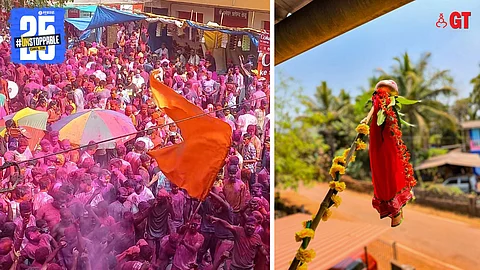

If you're visiting Goa at this time of year, among other things you'll get to witness festivals and the local agricultural scene, and even the connection between the two.
As peninsular India prepares for the New Year on March 30, two days before the start of the financial year and tax assessment year, the celebration is rich in colour, flowers and the fruits of the spring season.
Known as Xim-ga (meaning ‘of the border’) utsav, the festivities usher in the Indian New Year. Marked by the celebration of Gulal at Zambaulim, in the erstwhile kingdom of Sonde, it is a prelude to the Sonvsar Paddvo in Konkani or Gudi Padwa in Marathi, Yugadi in Kannada and Ugadi in Telugu.
For Goans, it is also the harvest time for rabi (or vaingonn) rice and cowpea (known locally as alsandde or chauli). The Persians and Parsis celebrate Navroz, as their New Year is celebrated around the same time, March 19 this year.
The Sindhi community celebrates the festival as Cheti Chand, just past the Equinox on March 21 that heralds the coming summer.
This year, the Chichonkars celebrated rice with the Baattachem Fest with enthusiasm whipped up by their in-house musician, O’luv.
The rice crop this season is predominantly the short-duration Jyoti variety. The Chinchinim Agriculture Club has begun cultivating the rabi or vaingonn crop of rice, where irrigation has been restored by community efforts supported by the water resources department (WRD).
This year, the Chichonkars celebrated rice with the Baattachem Fest with enthusiasm whipped up by their in-house musician, O’luv.
CROPS OF THE SEASON
Cowpea is the primary crop in rice fallows, where irrigation from canals, ponds, or springs is unavailable. Villages with sandy soils grow sweet potatoes and watermelons, which are used in preparing sweet dishes for the New Year celebrations.
Mango is the fruit linked to Gudi Padwa, and its fresh leaves are also edible. They can be cooked as a vegetable or used in soup. During World War II, people in some parts of Singapore relied on mango leaves for survival.
Mango is the fruit linked to Gudi Padwa, and its fresh leaves are also edible. They can be cooked as a vegetable or used in soup. During World War II, people in some parts of Singapore relied on mango leaves for survival.
My grand uncle, Dr Caetano Xavier Furtado, was even awarded for promoting this in his place of work – the Botanical Gardens of Singapore. Our ancestors likely understood the importance of such knowledge.
Mango leaves are also an integral part of Goa’s New Year celebrations, where they are used to create a toran (decorative hangings) over doorways and a guddi, which consists of a pole, a copper pot, cloth, and flowers attached to the top.
Watermelons are a source of pride for the farmers of Parra. Dasharat Madgaonkar from Britto Vaddo-Parra gained recognition this year for his watermelons and winter vegetables.
Meanwhile, Kalindi Salgaokar from Bhatiwadi-Parra blends her passion for watermelons with a love for chrysanthemums.
Many may not see farming as glamorous, but Darshana Pednekar from Silvavaddo-Parra proves otherwise. She has turned her crops into a thriving business, earning enough to build a home and expand further. Her achievements are part of the celebration.
Local entrepreneurship is flourishing with weekly ‘community markets’ having sprung up in neighbouring Saligao, organised by Emera Remedios; and in Pilerne, hosted by Fr Derrick Fernandes; with both villages being in Bardez taluka.
This initiative was inspired by the Goan Farmers' Market by Chiara Viegas e Tulkar in Margao, who has now moved her operations to Navelim, in South Goa. There’s a growing need for more of these markets in Goa.
(The author is the former Chairman of the GCCI Agriculture Committee, CEO of Planter's Choice Pvt Ltd, Additional Director of OFAI and Garden Superintendent of Goa University, and has edited 18 books for Goa & Konkan).